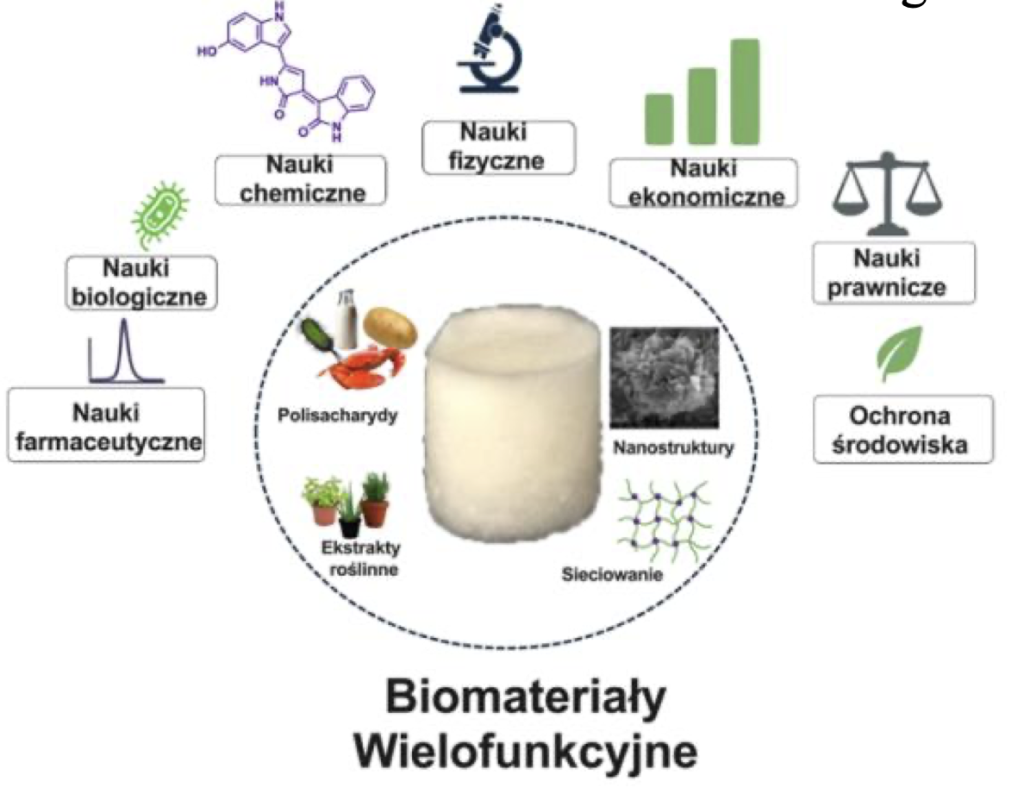Project Leader: Dr. Dorota Chełminiak-Dudkiewicz
Controlling the biocompatibility, therapeutic efficacy, and ability of modern wound dressing materials to intelligently respond to the dynamically changing wound microenvironment remains one of the key challenges in the field of advanced biomaterials. Currently available solutions rely largely on passive synthetic polymers and toxic cross-linking agents, significantly limiting their clinical potential and raising concerns about environmental and biological safety.
Therefore, there is an urgent need to develop next-generation, intelligent, biofunctional materials that combine biodegradability, biological activity, and the ability to selectively and adaptively respond to physiological and exogenous stimuli—such as pH changes, the presence of pathogens, temperature fluctuations, and light exposure.
The aim of this project is to design and synthesize multifunctional, biocompatible wound dressing materials based on a synergistic combination of natural polysaccharides, bioactive phytochemicals, and nanostructured protein components. Each component will be designed to fulfill a specific function: structural, antimicrobial, or regenerative – as part of an integrated theranostic system. A key innovation will be the use of non-toxic, biocompatible cross-linking agents based on modified proteins, enabling precise control of the mechanical properties, biodegradation rate, and microarchitecture of the material without the use of potentially harmful chemical reagents. Photoreactive components, such as photosensitizers and photosensitive cross-linkers, will also be incorporated, enabling temporally and spatially controlled activation of therapeutic functions. Thanks to these properties, the developed material will be able to dynamically respond to changes in wound condition – for example, by activating its antimicrobial activity only in the presence of infection. The resulting dressing will be completely biodegradable, safe, and capable of adaptively adapting to the various phases of the healing process. To date, there is no wound dressing material that holistically combines biologically active function, environmental responsiveness, and structural integrity, indicating a significant gap in current knowledge.
The project will be carried out by an interdisciplinary research team with a proven track record in biomaterial engineering for wound care applications. The group possesses expertise in polysaccharide and protein modification, as well as in the design and testing of photosensitizers, as evidenced by numerous publications in renowned scientific journals. The team has extensive instrumentation, including ATR-FTIR, UV-Vis spectroscopy, SEM, a contact goniometer, a spectrofluorometer, a texture analyzer, and freeze dryers. Thanks to collaboration with the Faculty of Pharmacy, advanced analytical techniques such as HPLC, mass spectrometry, and stability testing in environmental chambers are also available. Support from the Faculty of Physics will enable the use of fluorescence microscopy techniques, while the Laboratory of Instrumental Analysis (PAI) provides access to SEM, TEM, NMR, and thermal analysis (TGA-DTA) equipment.
The project also envisages extensive interdisciplinary collaboration with other scientific fields. Pharmaceutical scientists will be responsible for assessing the biocompatibility and release kinetics of active ingredients; biologists will be responsible for microbiological studies, cytotoxicity analyses, and in vitro assessment of cellular responses; and environmental scientists will be responsible for assessing biodegradability, ecotoxicity, and environmental impact. Physicists will be involved in structural analysis and photoreactivity studies of the materials, while economists will conduct analyses of costs, raw material availability, and commercialization potential. The legal team will provide support in intellectual property protection, regulatory compliance, and preparation of the materials for clinical implementation.

